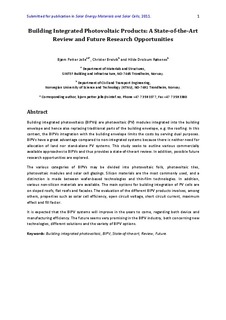| dc.contributor.author | Jelle, Bjørn Petter | |
| dc.contributor.author | Breivik, Christer | |
| dc.contributor.author | Røkenes, Hilde Drolsum | |
| dc.date.accessioned | 2017-04-05T10:56:29Z | |
| dc.date.available | 2017-04-05T10:56:29Z | |
| dc.date.created | 2012-02-14T18:36:06Z | |
| dc.date.issued | 2012 | |
| dc.identifier.citation | Solar Energy Materials and Solar Cells. 2012, 100 69-96. | nb_NO |
| dc.identifier.issn | 0927-0248 | |
| dc.identifier.uri | http://hdl.handle.net/11250/2436844 | |
| dc.description.abstract | Building integrated photovoltaics (BIPVs) are photovoltaic (PV) modules integrated into the building envelope and hence also replacing traditional parts of the building envelope, e.g. the roofing. In this context, the BIPVs integration with the building envelope limits the costs by serving dual purposes. BIPVs have a great advantage compared to non-integrated systems because there is neither need for allocation of land nor stand-alone PV systems. This study seeks to outline various commercially available approaches to BIPVs and thus provides a state-of-the-art review. In addition, possible future research opportunities are explored.
The various categories of BIPVs may be divided into photovoltaic foils, photovoltaic tiles, photovoltaic modules and solar cell glazings. Silicon materials are the most commonly used, and a distinction is made between wafer-based technologies and thin-film technologies. In addition, various non-silicon materials are available. The main options for building integration of PV cells are on sloped roofs, flat roofs and facades. The evaluation of the different BIPV products involves, among others, properties such as solar cell efficiency, open circuit voltage, short circuit current, maximum effect and fill factor.
It is expected that the BIPV systems will improve in the years to come, regarding both device and manufacturing efficiency. The future seems very promising in the BIPV industry, both concerning new technologies, different solutions and the variety of BIPV options. | nb_NO |
| dc.language.iso | eng | nb_NO |
| dc.publisher | Elsevier | nb_NO |
| dc.rights | Attribution-NonCommercial-NoDerivatives 4.0 Internasjonal | * |
| dc.rights.uri | http://creativecommons.org/licenses/by-nc-nd/4.0/deed.no | * |
| dc.title | Building Integrated Photovoltaic Products: A State-of-the-Art Review and Future Research Opportunities | nb_NO |
| dc.type | Journal article | nb_NO |
| dc.type | Peer reviewed | nb_NO |
| dc.source.pagenumber | 69-96 | nb_NO |
| dc.source.volume | 100 | nb_NO |
| dc.source.journal | Solar Energy Materials and Solar Cells | nb_NO |
| dc.identifier.doi | 10.1016/j.solmat.2011.12.016 | |
| dc.identifier.cristin | 909082 | |
| dc.description.localcode | © 2011 Elsevier B.V. All rights reserved. This is the authors' accepted and refereed manuscript to the article. | nb_NO |
| cristin.unitcode | 194,64,35,0 | |
| cristin.unitname | Institutt for bygg, anlegg og transport | |
| cristin.ispublished | true | |
| cristin.fulltext | original | |
| cristin.fulltext | postprint | |
| cristin.qualitycode | 2 | |

